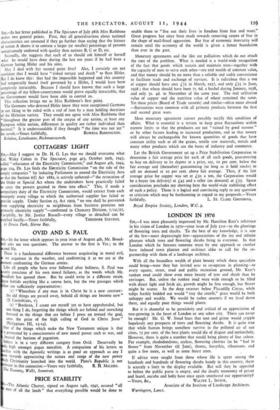LONDON IN 1970
siR,—I was most pleasantly impressed by Mr. Hamilton Kerr's reference in his vision of London in 1970—your issue of July 21St—to the plantings of flowering trees and shrubs. To the best of my knowledge, it is one of the few—most depressingly few—appreciations of the joy and infinite pleasure which trees and flowering shrubs bring to everyone. In that London which he foresees someone must by one approach or o.nother have induced town planner and architect alike to call for the co- partnership with them of a landscape architect.
With all the boundless wealth of plant beauty which these specialists
could bring—were they but invited now to co-operate in planning—to
every square, street, road and public recreation ground, Mr. Kerr's
sunken road could show even more beauty of tree and shrub than he envisages. But, unless the sunken road were wide enough to be filled with direct light and fresh air, growth might be free enough, but flower might be scanty. In the deep recesses below Piccadilly Circus, while tulips freshly bedded out would "stay the cour?e," grass would be both unhappy and weakly. We would be rather anaemic if we lived down there, and equally poor things would plants.
But it is shameful to be pernickety and critical of an appreciation of tree-growing in the heart of London or any other city. There can never be enough! Mr. G. W. Stead fears that soot and grime would cripple hopelessly any prospects of trees and flowering shrubs. It is quite true that while human beings somehow survive in the polluted air of our cities, 75 per cent, of the best plants would die of disgust and melancholy. However, there is quite a number that would bring plenty of fine colour. For example, rhododendrons, azaleas, flowering cherries (to be "had in flower" from November till June), thorns, forsythia, viburnums and quite a few more, as well as some forest trees.
If advice were sought from those whose life is spent among the hundreds and hundreds of flowering shrubs handy in this country, there is scarcely a limit to the display available. But will they be appealed to before the public purse is empty, and the deadly monotony of privet and laurel, aucuba and holly have once again smothered our opportunity?
Associate of the Institute of Landscape Architects. Warrington, Lancs.


























 Previous page
Previous page